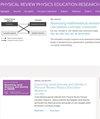利用晶体结构开发关于物质微粒性质的新教学序列
IF 2.6
2区 教育学
Q1 EDUCATION & EDUCATIONAL RESEARCH
Physical Review Physics Education Research
Pub Date : 2023-12-26
DOI:10.1103/physrevphyseducres.19.020169
引用次数: 0
摘要
在学习物质的微粒性质(PNM)时,学生往往将相同的性质归于微粒及其组成的物质。有人认为,这可能是因为他们归类错了本体论的范畴。要解释亚微观和宏观物质之间的关系,学生需要理解 "涌现 "的概念。在先前工作的基础上,作者提出晶体结构可能是引入 PNM 的合适背景。由于粒子的行为与晶体的性质之间存在密切联系,学生可以学习涌现的概念,从而加深对 PNM 的理解。本研究采用基于设计的研究方法框架,调查学生在晶体结构背景下学习 PNM 的情况。研究的目的是开发一个关于 PNM 的原型教学序列(TLS),并帮助开发该学科的本土教学理论。在设计和完善 TLS 的几个周期中,采用探究接受法共进行了 40 次访谈。通过对内容进行评价性定性分析,我们对学生对 PNM 的想法有了新的认识,并进一步完善了 TLS。例如,我们发现盐和雪的晶体比扫描隧道显微镜下的石墨图像更能帮助学生理解物质的宏观和亚微观层面之间的联系。本文章由计算机程序翻译,如有差异,请以英文原文为准。

Development of a new teaching-learning sequence on the particulate nature of matter using crystal structures
When learning about the particulate nature of matter (PNM), students tend to attribute the same properties to both particles and to the substances they compose. It has been argued that this might be explained by them categorizing the wrong ontological category. To explain the relationships between submicroscopic and macroscopic levels of matter, students need to understand the concept of emergence. Building on prior work, the authors propose that crystal structures might be a suitable context for the introduction of the PNM. As there is a close connection between the behavior of the particles and the properties of crystals, students can learn the concept of emergence and therefore gain a deeper understanding of the PNM. This study investigates students’ learning about the PNM within the context of crystal structures following the methodological framework of design-based research. The aim of the study is the development of a prototypical teaching-learning sequence (TLS) on the PNM and to help developing local theories for teaching that subject. Throughout several cycles of designing and refining the TLS, a total of 40 interviews were conducted using the method of probing acceptance. Evaluative qualitative content analysis led to new insights into students’ thinking about the PNM and allowed for further development of the TLS. For example, we found that salt and snow crystals were a more effective learning context than a scanning tunnel microscopy image of graphite for students to come to understand the connection between macroscopic and submicroscopic levels of matter.
求助全文
通过发布文献求助,成功后即可免费获取论文全文。
去求助
来源期刊

Physical Review Physics Education Research
Social Sciences-Education
CiteScore
5.70
自引率
41.90%
发文量
84
审稿时长
32 weeks
期刊介绍:
PRPER covers all educational levels, from elementary through graduate education. All topics in experimental and theoretical physics education research are accepted, including, but not limited to:
Educational policy
Instructional strategies, and materials development
Research methodology
Epistemology, attitudes, and beliefs
Learning environment
Scientific reasoning and problem solving
Diversity and inclusion
Learning theory
Student participation
Faculty and teacher professional development
 求助内容:
求助内容: 应助结果提醒方式:
应助结果提醒方式:


